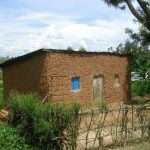It being Sunday in Ireland, the newspapers will be bulging. Despite the recession, the supplements seem not to have diminished and the prices of the wares being advertised seem hardly to have fallen. There still seem to be sufficient people with money to spend to make glossy advertising a worthwhile exercise. Who would want to spend money on some of the trivia pictured seems a mystery, but the market must be there.
The Homes and Living sections are always the most fascinating, there really are people whose houses are filled with a minimalist sterility or exclusive designer furniture; not a worn out settee or a dog hair or a dirty coffee cup in sight.
It is such supplements that mark the greatest contrast between European opulence and African realities. Because of a deal that provided the parish with a new house for nothing, our home from 2007 until 2010, included marble floors with underfloor heating, granite worktops , en suite bathrooms, two jacuzzis, solar panels, a central vacuum system; a house far beyond our dreams. A Burundian friend living in the city centre came to stay overnight on one occasion, ‘So I can say that I have stayed in a house such as this’.
Aspirations to an ideal home in much of rural Africa would be a stark contrast with the shiny suburban dwellings of our Sunday supplements. A des. res. might include:
(i) Concrete walls and floors so as to be able to try to stay dry in the wet season.
(ii) Glass in the windows, or at least mosquito screens, to try to reduce the constant threat of malaria.
(iii) A kitchen that was not dependent upon charcoal or firewood for cooking, making the house cleaner and healthier and helping avoid deforestation.
(iv) A mains water tap, so that water does not have to be fetched by the women and children from hundreds of metres, if not kilometres away
(v) A latrine in the garden, so as not to have to share with the neighbourhood
(vi) A tarmac road through the village, so that catching a bus or motor cycle taxi would be easier, and that markets for selling and buying would be easily reached
(vii) A school within a couple of kilometres, so that the children do not spend a third of their waking hours walking
(viii) Electricity to the village, if not to the house, so that there might be facilities in the community.
(ix) A village clinic that would provide education in hygiene and disease prevention, as well as providing primary health care and maternity facilities
(x) A garden in which to grow vegetables and fruit for good nutrition, and even some space for flowers because, when you are poor, things of beauty become even more important.
It is humbling to encounter homes and living in a world where reality is so sharply drawn.
